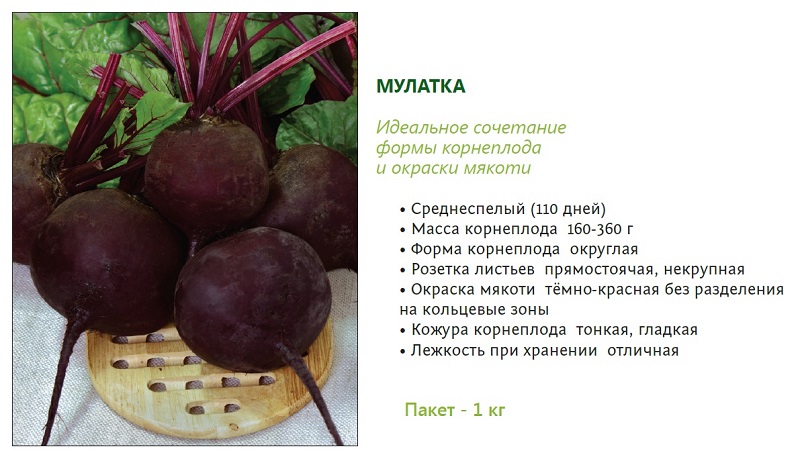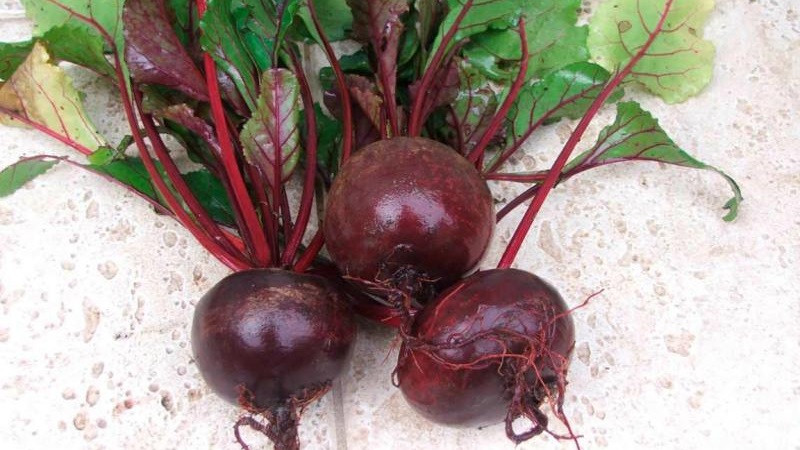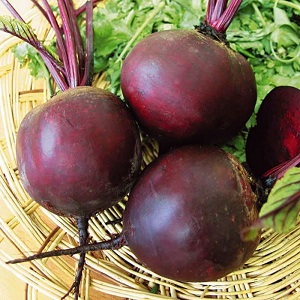Sweet and full of vitamins beets "Mulatka": how to grow a rich harvest and where to use it
Beetroot is an indispensable product both in the ordinary kitchen and in the food industry. For example, beetroot powder is a natural color that is present not only in ketchups and pastes, but also in sweet desserts. In addition, the vegetable is extremely healthy, contains a rich complex of vitamins and minerals. In order not to waste time looking for quality beets in supermarkets, many gardeners prefer to grow them on their own.
Among all the variety, the Mulatka variety stands out; it is loved for its sweet taste and ease of care. Let's take a closer look at what the beet variety Mulatka is and how to get a good harvest.
The content of the article
Description of the variety
The mulatto is a mid-season variety, the first crop is harvested 110-120 days after planting. The variety is a favorite of many gardeners, its fruits have a wonderful juicy taste and an attractive presentation.
Origin and development
The Mulatka variety appeared thanks to the labors of Russian breeders in the late 80s of the twentieth century. The plant quickly became widespread among gardeners and farmers. In addition to Russia, the crop is actively grown in Ukraine, where beets are called "beetroot", in Moldova and Belarus. To this day, the Mulatka variety is valued for its high yield and disease resistance.
Distinctive features
Medium-sized beetroot bushes, oval leaves, light green. The plate is smooth with wavy edges. The plant has a high immunity to bad weather and other external factors. Mulatto has a long shelf life, does not lose its taste and appearance.

Fruit characteristics and yield
Fruit weight varies from 160 to 350 g. The color is red-burgundy, saturated. The surface of the beets is smooth and even, and the shape is round. The flesh is tender and juicy, with a high sugar content. From 1 sq. m summer residents collect about 5 kg of ripe and mouth-watering fruits.
Interesting! Due to its unpretentious care, beets are cultivated even in the Magadan and Sakhalin regions, as well as in Yakutia.
How to grow
Growing mulatto beets is a simple process, the main thing is to follow all agrotechnical techniques and rules. The culture is planted in a seedling or non-seedling way. The first is suitable for regions with unpredictable climatic conditions, the second is appropriate in areas with warm weather and fertile soil.
Planting with seeds
Before planting with seeds, be sure to disinfect the seed with a solution of potassium permanganate or aloe juice. Place the seeds in a cloth bag, then dip it into the prepared liquid. Disinfection reduces the risk of developing diseases in the future, and also increases the plant's immunity.
The next step is preparing the land. Beets are an unpretentious plant, but it is better to plant them on dry and loose land. At the end of October, dig up future beds, remove all debris, burn the weeds. With the arrival of spring, re-dig the earth, then add river sand or lime to the beds. This is necessary in order to loosen the soil and reduce its acidity.
Once the beds are ready, make small grooves in the ground, 30 cm apart. Place the disinfected seeds in them and sprinkle with earth on top, watering abundantly with warm water.
Important! Experienced farmers advise using rainwater for irrigation. Its composition is optimal for watering young seedlings, does not contain pathogenic microorganisms. To easily collect rainwater, simply place a couple of empty tanks in the area. If there is a house nearby, build drainage surfaces over the containers.
Planting seedlings
Seedlings help the sprouts to take root faster in the beds, transfer frost and other unfavorable conditions without problems. For seedlings, you need a container. It can be anything: milk or kefir bags, wooden boxes, flower pots, and even plastic cups. Do not forget to thoroughly wash the container before planting, dry it and treat it with a weak solution of manganese.
Prepare the seedlings in advance. Some gardeners prefer to use a mixture of soil from the garden, peat and humus. Other gardeners acquire special Krepysh soil or Universal soil. The main thing is that the land is clean, free of dangerous microbes, larvae and foreign debris. To be sure of the quality of the soil, gardeners are advised to disinfect the ground with an ash solution.
Seedlings are prepared 3-4 weeks before planting beets in the ground. Seeds are planted at a distance of 2 cm from each other. After sowing, sprinkle with a thin layer of earth and watered with a small amount of water, about 1 liter per 1 kg of soil. Then the seedlings are covered with foil or thin glass and placed in the warmest and lightest place in the house. As a rule, this is a windowsill.
Important! Beet seedlings require attention and care. Water the sprouts every 7 days, mainly in the morning or evening. Use only filtered warm water. After 2 weeks from the moment of planting, the seedlings are fed with liquid bird droppings or nettle infusion. For a more accelerated development, the growth stimulator "Kornevin" is added.
Care
 Timely and competent care is the key to a delicious rich harvest. When watering, be guided by the weather conditions. If the summer is hot and humid, water the beet beds every 7-10 days. If the weather is dry and there is no rain, moisten the soil once every 5 days. Use only rainwater or settled water. To avoid sunburn, moisten the soil early in the morning or after sunset.
Timely and competent care is the key to a delicious rich harvest. When watering, be guided by the weather conditions. If the summer is hot and humid, water the beet beds every 7-10 days. If the weather is dry and there is no rain, moisten the soil once every 5 days. Use only rainwater or settled water. To avoid sunburn, moisten the soil early in the morning or after sunset.
After watering, a thin crust may form on the soil. It makes it difficult for oxygen to reach the roots. Therefore, the beds need to be loosened regularly. The soil is loosened every 7 days, combined with the removal of weeds. Weeding keeps the beds clean and conditions for the normal development of beets.
Beet Mulatto needs mineral fertilizing and organic fertilizers. It can be root dressing, for example, potassium chloride or superphosphate, as well as foliar - pollination of bushes with soap or onion solution.
In total, during the ripening period of the culture, 3-4 dressings are carried out, which not only protect the beds from diseases and pests, but also improve the taste of the fruits.
Features of cultivation and possible difficulties
Be careful with nitrogen supplements, as their excess causes an increased level of nitrates in the fruit. Apply fertilizers containing copper, boron and molybdenum on time. Otherwise, the quality of the fruit will deteriorate significantly.
If the beet leaves turn a light shade, urgently feed the plants with potassium supplements. There are situations when tops becomes red. This means that the plant lacks sodium or the acidity level is exceeded in the soil. To eliminate the problem, gardeners are advised to sprinkle the beds with ash and water the bushes with salt water.
Interesting! In ancient Rome, beets were considered a symbol of quarrels. However, people still actively ate roots, tops and even the roots of young plants. Before that, the Romans soaked them in water and sprinkled with pepper.
Tips from experienced gardeners
To increase the quantity and quality of the crop, experienced gardeners recommend using special rules and growing secrets.
Important recommendations:
- cucumbers, potatoes, onions and tomatoes are recognized as the best predecessors for beets;
- do not plant after carrots or other beet varieties;
- for more sugar, water the beds with a solution of salt at the rate of 1 tbsp. l. for 10 liters of water;
- beets love moisture - per 1 sq. m takes about 20 liters of water;
- use a drip irrigation system whenever possible. It saves water and directs it directly under the root, bypassing stems and leaves;
- a month before harvesting, try not to overmoisten the soil;
- to accelerate growth, cover the beds with vermiculite or peat.

Diseases and pests
With improper care, the culture can get sick with fungal infections or viral diseases.
The most common ones are:
- Powdery mildew, appears as a white bloom on leaves and stems. The causes of the disease are high humidity, contaminated soil, untimely weeding of the beds. As a preventive measure, water the bushes with a solution based on aloe juice, follow the rules of crop rotation. If powdery mildew has already appeared in the beds, treat the affected areas with ground sulfur.
- Phomosis primarily affects the leaves, covers them with yellow spots. After 2-3 days, the disease spreads to root crops, and the beets begin to rot. To prevent phomosis, spray the garden with a solution of Bordeaux liquid. For treatment, it is necessary to pickle the beds with 0.4% copper oxychloride.
Of the pests, beet midges and aphids attack the beds. Insects settle on the leaves of plants and suck out the vital sap from them. For this reason, the development of fruits slows down, the taste deteriorates. For prevention, gardeners are advised to spray the beds with soapy water, loosen them in time and remove weeds.
Another dangerous pest is the bear. The insect lives in the ground, does not die even in winter at low temperatures. Medvedka lays eggs and nests under the beds. The larvae begin to gnaw the roots of the plant, which leads to metabolic disorders. Dry eggshells or spraying the beds with a solution of copper sulfate will help get rid of the bear.
Harvesting and application of the crop
 Harvest Mulattos are harvested before the first frost. Dig up the beets with a pitchfork, then clear them of the earth and lay them out on the garden bed. Next, the tops are cut off, leaving a small petiole. For storage, even and beautiful fruits are selected, without scratches and rot.
Harvest Mulattos are harvested before the first frost. Dig up the beets with a pitchfork, then clear them of the earth and lay them out on the garden bed. Next, the tops are cut off, leaving a small petiole. For storage, even and beautiful fruits are selected, without scratches and rot.
Vegetables are best stored in wooden or plastic containers with plastic wrap on top. The optimum air temperature for storing mulatto beets is from 0 to +2 degrees.
The variety is used to prepare a wide variety of dishes. For example, a salad of garlic and prunes will be a great addition to dinner, and a festive table will be decorated with a liver and beetroot cake. Beetroot salad with nuts, borscht, herring under a fur coat, vinaigrette are also very popular.
Plus, sweet and healthy desserts are prepared from beets: beet pancakes on fermented baked milk, chocolate pie with beets and nuts, beet pancakes.
Interesting! Beets - universal homemade medicine... It has anti-inflammatory, diuretic and wound healing effects. In addition, beets contain iodine, B vitamins, and minerals. Regular consumption of beets improves digestion, helps to reduce excess weight... The vegetable is ideal for dietary and baby food. Also, beets are an excellent remedy for the beauty of hair and skin.
Advantages and disadvantages of the variety
Gardeners consider the advantages of the Mulatka variety to be easy to care for, an attractive appearance and high taste. Beets are versatile in use; the fruits contain a large amount of sugar, which makes the dishes more delicious. Plus, Mulatka shows stable and excellent yields, despite the weather conditions and the growing region.
Disadvantages: from time to time, the vegetable gets sick or is exposed to insect pests. Otherwise, the Mulatka variety is characterized as fruitful and tasty.
Farmers reviews
There are a variety of reviews about the Mulatka variety on the Internet. Some gardeners call Mulatka their favorite variety, while others were unhappy with the harvest.
Maria, Oryol: “As far back as I can remember, all the time Mulatka has been growing beets on the site. I like the fact that she always turns out beautiful and even, with an appetizing burgundy color. I add to salads and soups, I do juice - the fruit tastes excellent. I recommend growing. "
Oleg, Moscow: “I planted Krasny Shar and Mulatka varieties on the plot, but I was especially pleased with Mulatka. The summer turned out to be dry, but the variety still showed an excellent harvest. From 1 sq. m collected 6 kg! In my opinion, this is an excellent indicator of yield, I will definitely plant next year. "
Aigul, Tyumen: “I planted the Mulatto woman in open ground. Unfortunately, after 3 weeks I saw aphids on small bushes. A soap solution helped to get rid of it. But the quality of the crop has deteriorated markedly compared to last year. Next season I will try to plant a more insect resistant variety. "
Conclusion
Beets are a useful and indispensable product in the diet. It gives the body vitamins, improves immunity. The most delicious vegetables are those that are grown on their own site. The Mulatka variety is versatile and easy to care for, so even a novice gardener will be able to get a decent harvest. In care, the Mulatka variety is simple, does not require special skills. At the same time, the beets grow beautiful and appetizing.